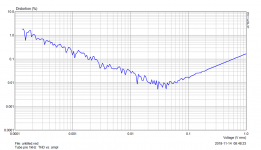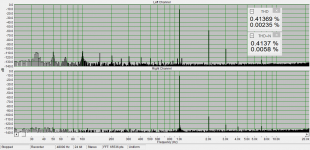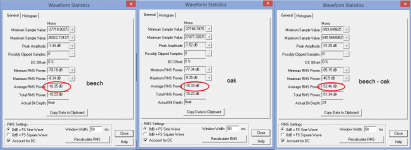Total: 6/8
Probability that you were guessing: 14.5%
Quite good result!
Someone might comment that 16-bit resolution is not enough. So here is a bonus, same test setup and same music but another take, now in 24-bit resolution saved as 32-bit floating point PCM wav.
http://pmacura.cz/trees.zip
Please do not test these new file against the old ones, because the level is now different.
http://pmacura.cz/trees.zip
Please do not test these new file against the old ones, because the level is now different.
That may be how it works for some people. For me it is the uncomfortable pressure of the cuff itself which raises blood pressure. Anyway, what has BP got to do with sound? The issue with BP is that it monitors something important to do with your health and longevity; being able to distinguish A from B is unimportant and will not affect your lifespan.ivanlukic said:Everybody knows that when your doctor measures your blood pressure it is enough to see the person in white coat and blood pressure jumps for several points immediately.
Those who are easily confused should avoid tests. They should also avoid commenting on tests.But my main point was that the brain is confused by the test and that is the only reason why it's impossible for most people to discriminate between samples.
What if A was music and B was silence - would you be able to distinguish in an ABX? My guess is yes. Therefore a positive result is not impossible. The question is: how different do A and B have to be to get a positive result? The ABX critics believe 'very different'; the ABX fans believe 'somewhat different'.You can't get positive result because nobody can!
So no test is possible, so we can never have any idea at all what type of electronics can reproduce music sufficiently well for us to hear something like the original sound? Why are you on an audio forum, when you believe that we cannot know anything useful?To reduce such complex brain activity, as hearing, to some mechanical test procedure is nonsense.
I am a bit confused now. You want to listen to a sample just once, yet ensure that you do this at the exact moment that "distortions are very high". How can you find this moment, given just one listen? What sort of defective audio system do you recommend, in order to ensure that these "very high distortions" are present?I think that the difference is easier to perceive if samples are played once than when samples are repeated several times as in the ABX test. But you obviously find the way to overcome confusion by finding exact moment in the sample when distortions are very high.
I would not like to make a test with a "defective audio" or with an audio component in clipping level. My intention was to bring the files where one of them has seemingly high non-linear distortion level, though remaining in a linear portion of the transfer characteristics. We may be confused by numbers or plots, but we may not be sure if such non-linear distortion level is audible or not with a music program.
THD vs. amplitude up to 1V of the tube stage is shown below, peaks in our test sample go somewhere to 2-3V, one may use straight line approximation. Distortion spectrum at 2V is shown in another graph below, left channel is the "tube channel" and right channel is the "wire channel" as used during the test.
THD vs. amplitude up to 1V of the tube stage is shown below, peaks in our test sample go somewhere to 2-3V, one may use straight line approximation. Distortion spectrum at 2V is shown in another graph below, left channel is the "tube channel" and right channel is the "wire channel" as used during the test.
Attachments
The poll has just expired. As you could read in another thread, the files were:
- ella1 recorded through a tube preamplifier
- ella2 recorded through a link cable
The test was more in deep described in this post:
Do you like tube distortion? - listening test
- ella1 recorded through a tube preamplifier
- ella2 recorded through a link cable
The test was more in deep described in this post:
Do you like tube distortion? - listening test
Someone might comment that 16-bit resolution is not enough. So here is a bonus, same test setup and same music but another take, now in 24-bit resolution saved as 32-bit floating point PCM wav.
http://pmacura.cz/trees.zip
Please do not test these new file against the old ones, because the level is now different.
For those who might live in an illusion that a non-linear distortion (in isolation) containing mainly the 2nd harmonic might sound "acceptable", I would like to act as a MythBuster. This popular belief, supported by popular audio magazines and people who probably just do not know is simply wrong. Mainly for the reason that not only harmonic components, but also intermodulations of all kinds are created as well.
I have used these newer 24-bit files to create a difference file, 24/bit files simply for the reason that we work with small resulting amplitudes and that the difference created from files with higher resolution is more precise. The "difference" between tube path and direct path can be downloaded from
http://pmacura.cz/trees_diff.zip
Small phase shift were suppressed so the result is mostly the non-linear distortion of the tube path only. Please tell me if you think that the resulting sound is "pleasing" to your ears.
Regardless how stressful the non-linear residuum sounds, one should bear in mind that the amplitude is small, if you compare volume with files from which the difference was created.
As a conclusion, non-linear distortion is never "pleasing", regardless distortion profile, the opposite is true. The only question is at which level of distortion it starts to be audible.
In the west in particular we are used to music using the equal tempered scale, it has become "harmonious" to our ears. I think this, and potential corruption of timbre, can also mean that 2nd harmonic distortion is only harmonious at octave intervals of the fundamental of played notes and most of the time will create additional dissonance within the scale. I can't see any reason 2nd harmonic distortion would be a good idea in reproduction.
I think that the difference is easier to perceive if samples are played once than when samples are repeated several times as in the ABX test. But you obviously find the way to overcome confusion by finding exact moment in the sample when distortions are very high.
Once I figured out how to hear the difference, its apparent all over the vocals. But under normal listening I'd never trust that I heard a difference. There'd be too much time between a and b to tell.
What surprised me was thinking I'd hear that 2nd harmonic most in the bass, but it turned up more in the vocals. Especially when Ella sang quieter.
I'm going to try it on the horn system this weeekend. Just curious how that compares to headphones.
Last edited:
From the USSA-3 class A by Fab
Post your Solid State pics here.
by HH
http://www.quebecdiyaudio.com/t756p...-version-lateral-et-all-fets-conception#17922
I think we need a new test, only with SS, with H2 predominance (70-75 dB) vs very clean amp.
I think that with acoustics instruments the sound is better with more H2.
Post your Solid State pics here.
by HH
[French] Amplificateur USSA-3: version Latéral et "all Fets "- conceptionThe USSA-3 has a very full and natural sound. All well recorded acoustic instruments will be reproduced in a very realistic way – almost tube like. Where solid state amplification excels in dynamics and detail, they often have a sort of hidden "whitish" glare that is – more often than not - less natural sounding than what a good tube amplifier can do.
Many good solid-state designs are somewhat tilted towards a bright sound reproduction, that highlights details and recording artefacts like studio walls and such. I think, too many audiophiles are focusing more on details and soundstage when choosing their system, instead of asking themselves the important questions: "Can this system really reproduce the nylon strings on a Spanish guitar? Can it reproduce the left side of a Steinway grand piano in a way that energize the room? Does this system reproduce the warm bloom of a bass solo on jazz recording?"
The USSA-3 do ALL these things more convincing than the other amplifiers I have built (that includes several Pass First Watt amplifiers).
http://www.quebecdiyaudio.com/t756p...-version-lateral-et-all-fets-conception#17922
An externally hosted image should be here but it was not working when we last tested it.
I think we need a new test, only with SS, with H2 predominance (70-75 dB) vs very clean amp.
I think that with acoustics instruments the sound is better with more H2.
Last edited:
I think that with acoustics instruments the sound is better with more H2.
This is a nonsense and a result of marketing propaganda of some audio producers.
This is a nonsense and a result of marketing propaganda of some audio producers.
Such is my listening experience with a lot of excellent recordings.
The best thing is a new test.
This is a nonsense and a result of marketing propaganda of some audio producers.
This is true, some 2n harmonics is alright but it is more invasive than a 3rd harmonic.
2nd although are already in recordings and produced naturally by instruments, same with 3rd etc, everything makes harmonics and overtone in music and human speech.
However 2nd harmonics are not my thing, I prefer (with support tests) to have less 2nd as possible and some 3rd as long as it is under control.
All other harmonics are sounding very unnatural.
From the USSA-3 class A by Fab
Post your Solid State pics here.
by HH
[French] Amplificateur USSA-3: version Latéral et "all Fets "- conception
Amplificateur USSA-3: version Lateral et "all Fets "- conception - Page 7
An externally hosted image should be here but it was not working when we last tested it.
I think we need a new test, only with SS, with H2 predominance (70-75 dB) vs very clean amp.
I think that with acoustics instruments the sound is better with more H2.
Although I give the possibility to adjust H2 in the USSA3 amplifier it does not mean that I am convinced that it’s high dominance is a good thing. In my own USSA3 amp I have tried with the H2 level of the FFT shown but have not preferred the sound over lower H2 level. In fact, another member listened to the amp with H2 adjusted lower than H3 and the sound of cello was the best he has heard - so he told me... at this point it may just be a matter of taste or simply a compensation for other parts of the system...
All other things being equal, lower feedback gives more H2 and H3 dominance than with high feedback.
I think it may be more the nature of the low feedback design that gives a different tone balance compared to a high feedback design.
My 2 cents...
Fab
Last edited:
You agree with me fab,
Maybe the bottom line is that this THD pattern is in fact very low at normal listening with 2V output. The way the amp control the speaker which is a complex load is the most important factor.
My understanding is that tube amps smear abrupt changes in sound, it can have an extended bandwidth and great impulse, however it will not grip the driver like SS, this let the driver have a more natural movement and smooth the music, like a sophisticated compressor. For example, polypropylene cones are smooth and less aggressive, using SS makes almost no differences. The situation changes with higher sensitivity cones, not because tube amps make less THD, tube amps of low power can play with low THD on low sens. drivers, however, with paper cones the smoothing of the harsh sound transition reduces the distortion of the paper due to abrupt and hard sound transitions, with a SS amp paper driver with high sensitivity appear to have less bass and shout more.
Maybe the bottom line is that this THD pattern is in fact very low at normal listening with 2V output. The way the amp control the speaker which is a complex load is the most important factor.
My understanding is that tube amps smear abrupt changes in sound, it can have an extended bandwidth and great impulse, however it will not grip the driver like SS, this let the driver have a more natural movement and smooth the music, like a sophisticated compressor. For example, polypropylene cones are smooth and less aggressive, using SS makes almost no differences. The situation changes with higher sensitivity cones, not because tube amps make less THD, tube amps of low power can play with low THD on low sens. drivers, however, with paper cones the smoothing of the harsh sound transition reduces the distortion of the paper due to abrupt and hard sound transitions, with a SS amp paper driver with high sensitivity appear to have less bass and shout more.
Such is my listening experience with a lot of excellent recordings.
The best thing is a new test.
We already had a lot of listening tests here with mathematically added non-linear distortion. Pure H2 as well, some H2 and H3 as well. However, as already said, in a "real thing" it is never non-linear distortion itself and only and the mechanism of sound change is much more complicated. Especially in power amplifiers. Attempt to explain the possible sound change by a sole non-linear distortion is usually incorrect.
With a new test we leave doubts.
I think H3 predominance is a bad idea.
And a big H2 predominance is a bad idea too. How much is correct?. Less of 70 dB so that all the music sounds good and not just the acoustic.
A good idea, to me, is a preamp with H2 predominance (less than 70 dB and adjustable) and poweramp very clean. And, off course, the RME ADI-2 DAC.
If you want very clean sound, RME like preamp too.
And so you have both worlds.
Without a new test we will only go around again and again.
I think H3 predominance is a bad idea.
And a big H2 predominance is a bad idea too. How much is correct?. Less of 70 dB so that all the music sounds good and not just the acoustic.
A good idea, to me, is a preamp with H2 predominance (less than 70 dB and adjustable) and poweramp very clean. And, off course, the RME ADI-2 DAC.
If you want very clean sound, RME like preamp too.
And so you have both worlds.
Without a new test we will only go around again and again.
I think that with acoustics instruments the sound is better with more H2.
This is a nonsense and a result of marketing propaganda of some audio producers.
My friend always likes amps with more distortion better than linear amps because distortion adds presence to sound,
The effect of H2 is pretty clear to me. It is not surprising at all if many people like it. Though the word 'better' shouldn't be used here as it is only a preference. Observe that only more experience people will at last (at the end) find out that distortion IS distortion. Not only that they will eventually learn the nature of the sound, but also because these experience people mostly have 'mature' system that can deliver enjoyment without the need for MSG (Mono-Sodium Glutamate).
The effect of the H2 is adding 'presence' as ivan said. The 'room effect' which is often missing in 'thin' sounding solid state systems.
In accoustics instruments, the room effect (thus harmonics/overtones) is important as it is part of the original sound/music.
For example, polypropylene cones are smooth and less aggressive, using SS makes almost no differences. The situation changes with higher sensitivity cones, not because tube amps make less THD, tube amps of low power can play with low THD on low sens. drivers, however, with paper cones the smoothing of the harsh sound transition reduces the distortion of the paper due to abrupt and hard sound transitions, with a SS amp paper driver with high sensitivity appear to have less bass and shout more...
I agree. My second system, with KEF Q100 coaxial and aluminum, with sensitivity of 85 dB, has more detail (and more soundstage and coherence thanks to very very good 5.25" coaxial) that my old BIG 3-ways with paper cones (big tweaked by me) and 91 dB (with 10.5" woofer).
The same music from my PC/player/config, Q100 with USB (tweaked ODAC) and 3-ways (Wi-Fi, lossless 24/96) sounds different. With some very good records I get excited but only with Q100. Two systems working in Direct mode, without eq, tones....
Music without EMOTION it is just an entertainment, it just accompanies us.
Last edited:
- Status
- This old topic is closed. If you want to reopen this topic, contact a moderator using the "Report Post" button.
- Home
- General Interest
- Everything Else
- Do you like tube distortion? - listening test


